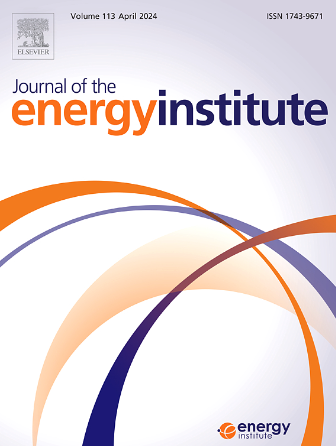Research on decoupling of in-cylinder combustion process of diesel/ammonia dual fuel engine
IF 6.2
2区 工程技术
Q2 ENERGY & FUELS
引用次数: 0
Abstract
Ammonia molecules contain no carbon atoms, which is a kind of clean fuel for diesel engines. The dual-fuel mode, combining ammonia and diesel, is an effective way for ammonia used in diesel engine, which complicates the combustion process. In order to decouple the combustion of diesel and ammonia, a bench test was conducted at 2700 rpm and 75 % load, and the in-cylinder pressure and instantaneous heat release at ammonia substitution rates of 0 %, 10 %, and 20 % were measured and analyzed. In addition, a combustion process model for ammonia and diesel fuel was developed, and a method for decoupling combustion characteristics based on consistent starting time of heat release was proposed. The results indicated that in the dual-fuel combustion mode (diesel/ammonia), the heat release curve was changed from a single peak to a double peak. The addition of ammonia reduced the pre-premixed heat release ratio, leading to a decrease in the peak instantaneous heat release rate and an extension of the combustion duration. As the ammonia substitution rate increased, the rate of ammonia consumption at the same crankshaft angle was significantly reduced. The burned mass center of ammonia (M50-NH3) was delayed by 4.2°CA, and the amount of unburned ammonia escaping was increased. After ammonia was added, the combustion area in the cylinder was extended toward the combustion chamber wall, and the high-temperature area in the center of the combustion chamber was decreased. With the increase in ammonia substitution rate, NH2+NO2=H2NO + NO became the most sensitive reaction, which was the main reaction that promoted ammonia combustion. The maximum ammonia substitution rate was 40 % at the maximum torque condition.
柴油/氨双燃料发动机缸内燃烧过程解耦研究
氨分子不含碳原子,是柴油机的一种清洁燃料。氨气与柴油相结合的双燃料模式是柴油机使用氨气的有效途径,但氨气的燃烧过程较为复杂。为了实现柴油与氨气燃烧的解耦,在2700转/分、75%负荷条件下进行了台架试验,对氨取代率为0%、10%和20%时的缸内压力和瞬时放热进行了测量和分析。此外,建立了氨和柴油燃烧过程模型,提出了基于一致放热启动时间的燃烧特性解耦方法。结果表明,在双燃料燃烧模式下(柴油/氨),放热曲线由单峰变为双峰。氨的加入降低了预混热释放比,导致峰值瞬时热释放率降低,燃烧持续时间延长。随着氨取代率的增加,相同曲轴角度下的氨耗率显著降低。氨(M50-NH3)燃烧质心延迟4.2°CA,未燃烧氨逸出量增加。加氨后,气缸内燃烧区域向燃烧室壁面延伸,燃烧室中心高温区域减小。随着氨取代率的增加,NH2+NO2=H2NO +NO成为最敏感的反应,是促进氨燃烧的主要反应。在最大转矩条件下,氨取代率最高可达40%。
本文章由计算机程序翻译,如有差异,请以英文原文为准。
求助全文
约1分钟内获得全文
求助全文
来源期刊

Journal of The Energy Institute
工程技术-能源与燃料
CiteScore
10.60
自引率
5.30%
发文量
166
审稿时长
16 days
期刊介绍:
The Journal of the Energy Institute provides peer reviewed coverage of original high quality research on energy, engineering and technology.The coverage is broad and the main areas of interest include:
Combustion engineering and associated technologies; process heating; power generation; engines and propulsion; emissions and environmental pollution control; clean coal technologies; carbon abatement technologies
Emissions and environmental pollution control; safety and hazards;
Clean coal technologies; carbon abatement technologies, including carbon capture and storage, CCS;
Petroleum engineering and fuel quality, including storage and transport
Alternative energy sources; biomass utilisation and biomass conversion technologies; energy from waste, incineration and recycling
Energy conversion, energy recovery and energy efficiency; space heating, fuel cells, heat pumps and cooling systems
Energy storage
The journal''s coverage reflects changes in energy technology that result from the transition to more efficient energy production and end use together with reduced carbon emission.
 求助内容:
求助内容: 应助结果提醒方式:
应助结果提醒方式:


